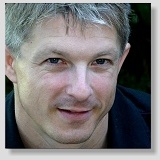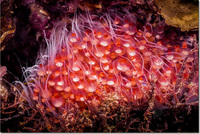Saturday, February 20. 2016
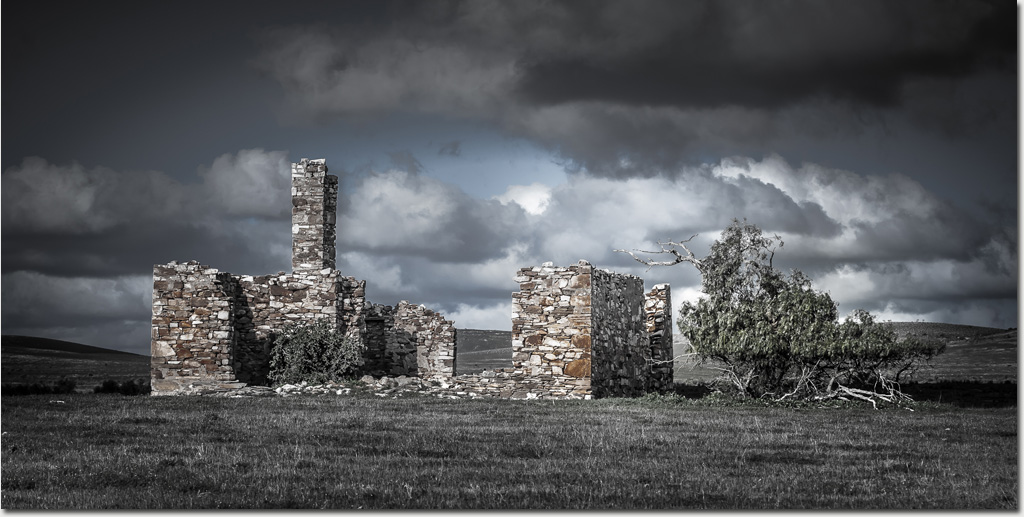
There is an imaginary line running through the north of South Australia called Goyder's Line which it was determined that farming above the line would be unviable to early settlers.
Following a long period of yearly above average rainfall many farmers decided to shun the warning and establish cropping farmland well to the north of the no-go boundary. In almost every case, nature had the last say in the matter and reclaimed its own back.
The ruins of this abandoned farmhouse near Hawker in South Australia's mid-north are a repeated sight all over this region. A poignant reminder that nature takes no prisoners.
Photo: Robert Rath, 'No Prisoners', 1/250s f/6.3 ISO100 70mm
Friday, February 19. 2016
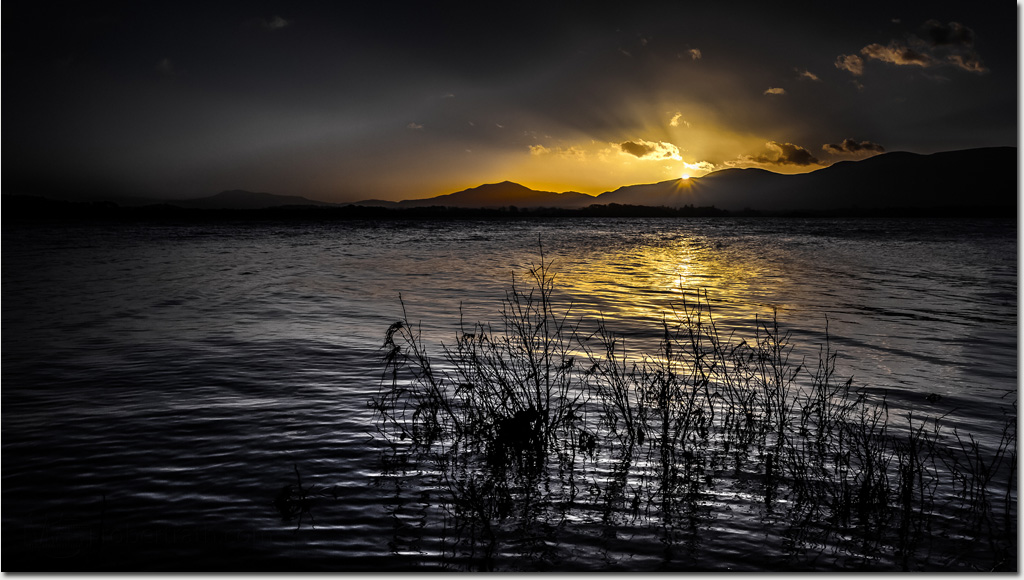
If there is one lesson I have learned in creating images is the simple act of showing up. Sometimes, showing up is easy, other times it borders on a sheer act of will against everything going against you!
I had one morning opportunity to visit the beautiful lakes region of Killarney in Ireland on my own such that I was free to go where I wanted and spend as much time as I liked. The weather had not looked good the days leading up and the forecast was not much better. Still I dragged myself out into the car in the rain, the wind and the pitch black winter's morning and set out on the hour long drive from were we were staying.
When I arrived at the shore of Lake Killarney it was still pitch black, raining and blowing a gale and I nearly drove into the lake thinking I was crossing a ford, that's how miserable it was. It was then I realised I was still on continental Europe time and it would be a long wait before there would any light at all.
To cut a long story short it eventually stopped raining, the wind started to ease off and then well into the morning light the clouds miraculously thinned away and then the sun rose over Lake Killarney.
I'm glad I showed up for this one.
Photo: Robert Rath, 'Killarney Dawn', 1/320s f/16 ISO160 29mm
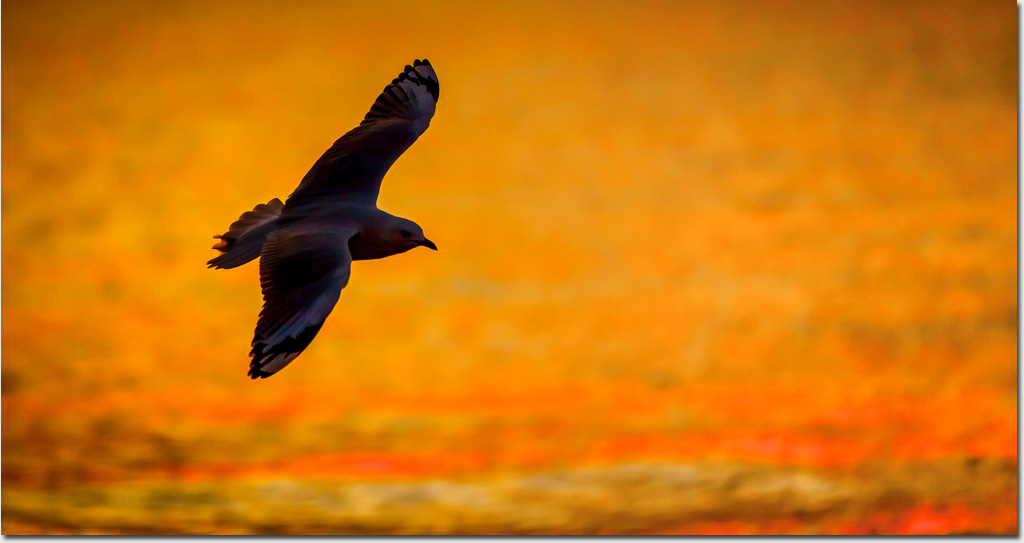
Features almost hidden in the glowing gold of sunset, almost a silhouette but just enough light to make out the texture of the seagull's feathers.
This is a special time of the evening to be down on the beach watching the world fly by.
Photo: Robert Rath, 'Fly By', 1/5000s f/2.8 ISO400 200mm
Wednesday, February 17. 2016
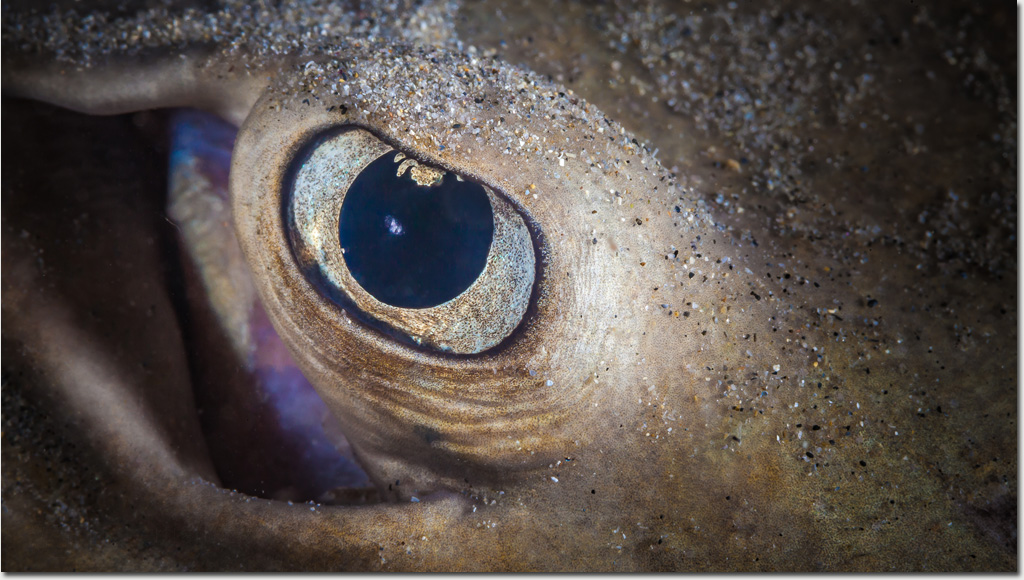
All divers who venture into the world of macro photography have a story or two about the giant bull ray or the swimming elephant that swam on up, peered over their shoulder, wondered for moment what ever could be that small and still be interesting before of swimming off again. Usually the first the diver even hears about the swimming elephant or the school of tuna they missed is from his or her excited buddy during debriefing over drinks.
This is my love hate relationship with the world of the macro. This time however the stingray rested quietly as I crept up, inching closer and closer, belly dragging through the sand.
That watchful eye never left me as we both wondered how close we could push it. Finally I dared not get any closer and captured that beautiful stingray gaze watching, wondering and waiting.
With that I crept back again creating space between us before rising and swimming away leaving nothing but belly scrapes in the sand and an undisturbed repose.
Photo: Robert Rath, ‘Watching Waiting Wondering' 1/160s f/22 ISO400 100mm
Tuesday, February 16. 2016
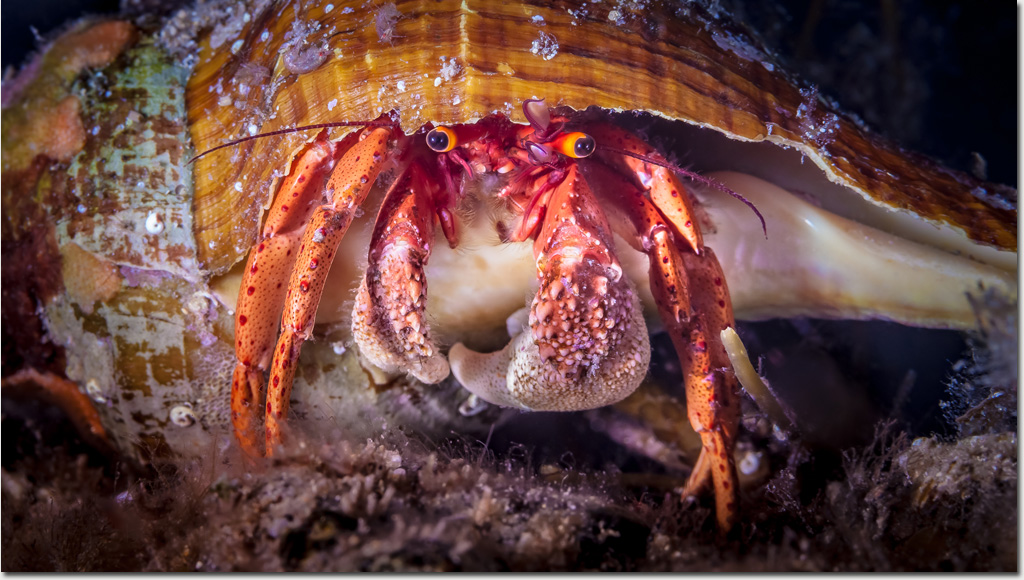
I immensely dislike the expression 'low hanging fruit' but when it comes to naturally photogenic, patient, and easy to photograph critters then hermit crabs fit the category.
This Hermit Crab ( Paguristes frontalisi) under Edithburgh Jetty is wearing a shell that is probably a new acquisition and watching it struggle around with a shell two sizes too big borders on the comical.
Looking at the way the leading edge of the shell has been cracked away I'd say the most recent tenant made some futile attempts at home renovation before abandoning it in search of a larger home.
For now this guy has room to shake, rattle and space to grow.
Photo: Robert Rath, ‘Shake, Rattle and Grow', 1/100s f16 ISO400 100mm
Monday, February 15. 2016
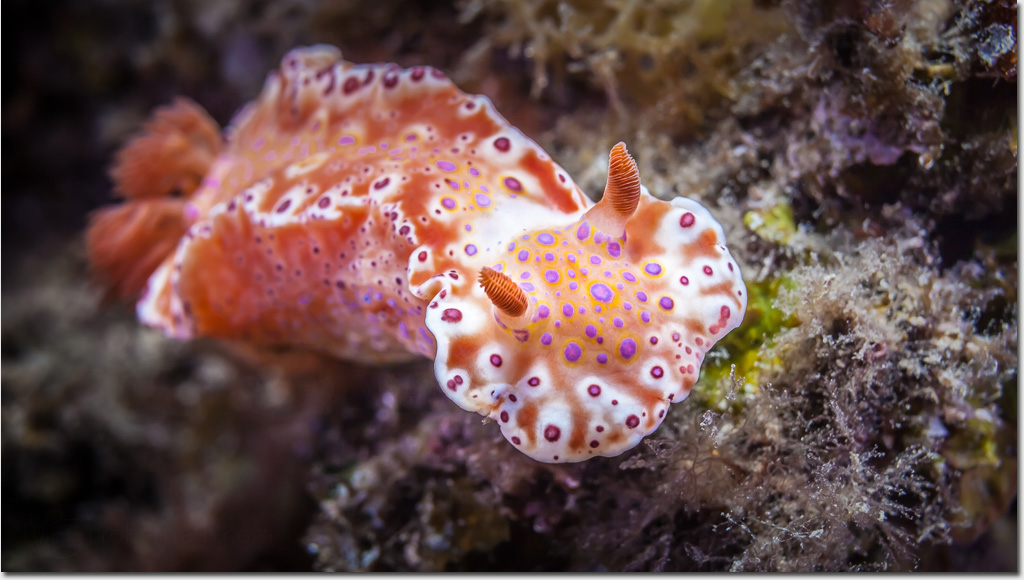
Our most common nudibranch (well at least I think it is) is Ceratosoma brevicaudatum and I still have no idea if it has a common name.
It's big as far as nudibranchs go. It is bright orange which makes it visible from meters away. Yet still many divers swim right on by.
I will confess that it was more than 20 years before I saw my first nudibranch. Quite simply, if it wasn't swimming, I didn't see it.
Underwater photography has completely changed the way I dive and the things I see diving. I'd recommend taking a camera underwater to all new divers once they have gained some water confidence.
Nudibranachs are just one of the many critters that have brought the little things underwater to life for me.
Photo: Robert Rath, ‘The Little Things', 1/160s f8 ISO100 100mm
Sunday, February 14. 2016
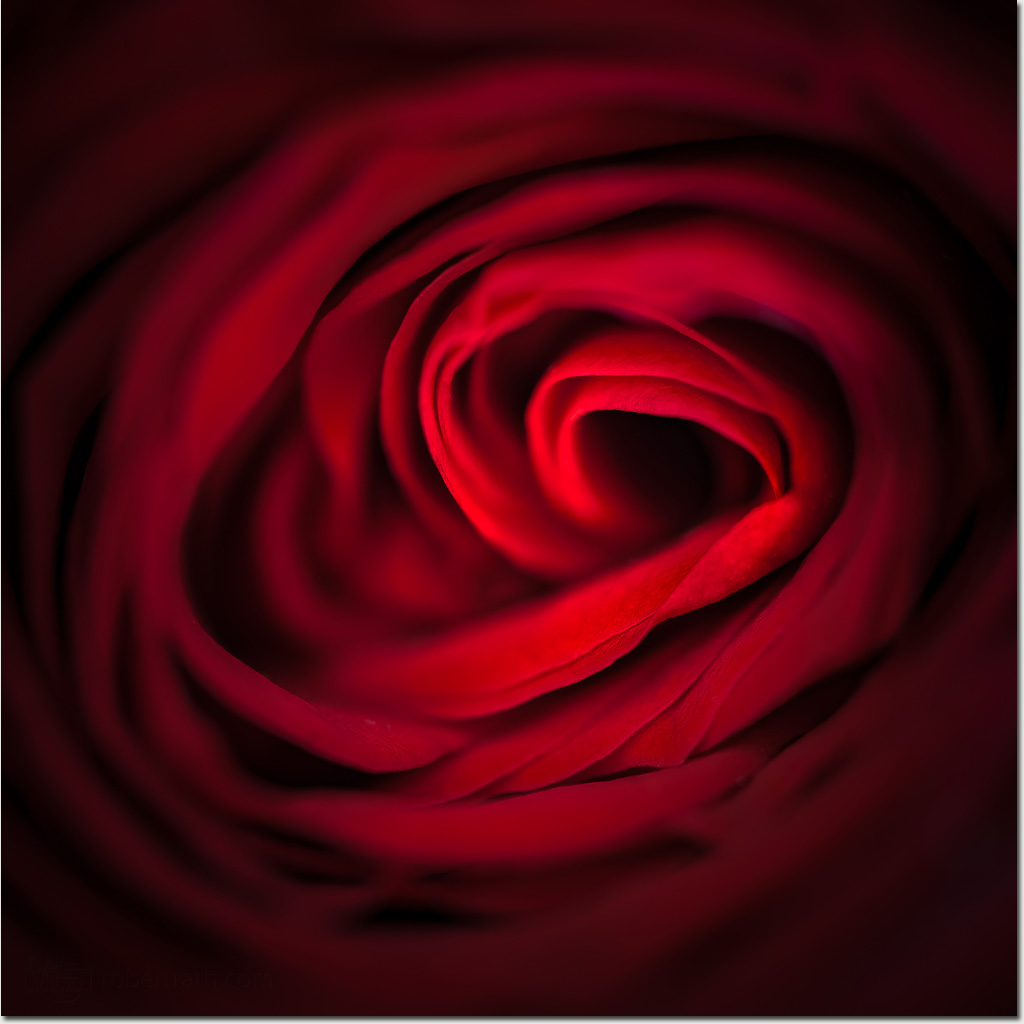
Happy Valentine's Day!
Photo: Robert Rath, 'Valentine Rose' 2.3s f/2.8 ISO200 100mm
Saturday, February 13. 2016
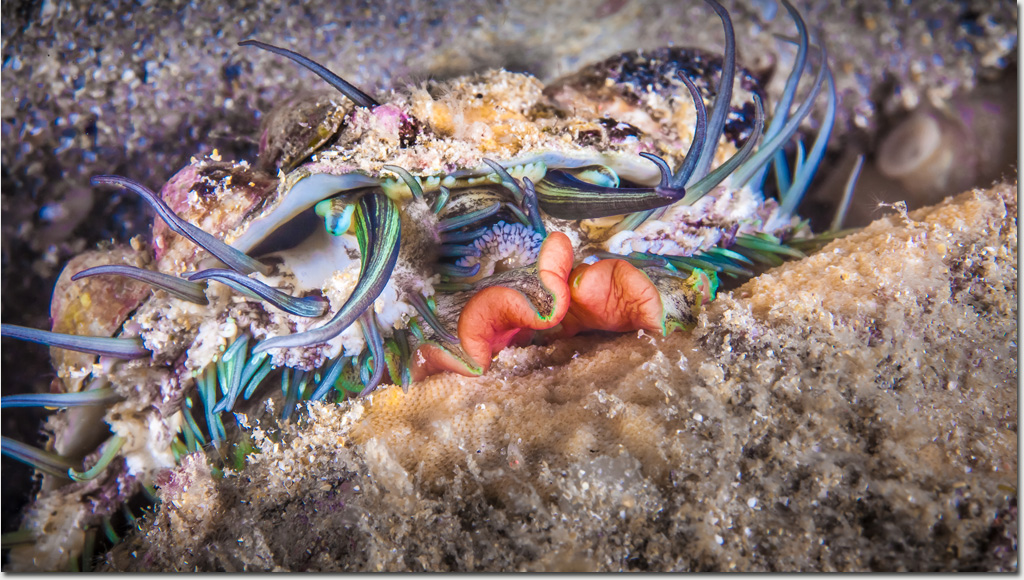
I have photographed hunting Blacklip Abalone ( Haliotis rubra), at Port Noarlunga before and commented on their utterly mad night time appearance of green eyes, tentacles and snailfish encrusted shell.
Observing images like this afterwards is always an eye opening lesson in observation for me. While photographing this guy, all I noticed as the abalone made its way across the reef was the abalone. On closer scrutiny, looking at a larger image in the comfort of sitting at my desk, I noticed something more. Can you see that this abalone is on the menu for dinner? It will not be a human that consumes this delicacy this evening but the stalking octopus creeping up from behind!
Next time I will be on the lookout for the bigger story unfolding in the scene.
Photo: Robert Rath, 'Abalone on the Menu' 1/160s f/22 ISO400 100mm
Thursday, February 11. 2016
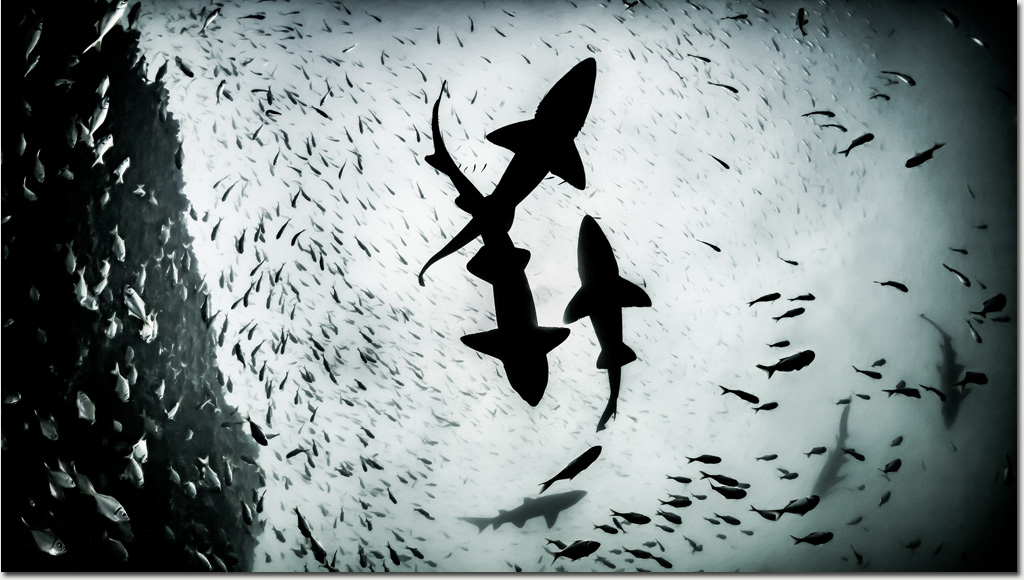
Just like looking out for overhead power lines it pays to look up when diving.
We teach new divers that they should never put themselves into a position where they can not make an immediate ascent to the surface if they come into difficulty.
It's all very well to be taught to be a good dive buddy, to be vigilant and always at the ready to assist your dive buddy should a problem arise but how often is that vigilance really put to the test.
More often than not when a manageable crisis arises, divers head straight up regardless of their buddy.
So remember to look up, there may be danger overhead.
Photo: Robert Rath, 'Danger Overhead', 1/160s f/22 ISO320 15mm
Tuesday, February 9. 2016
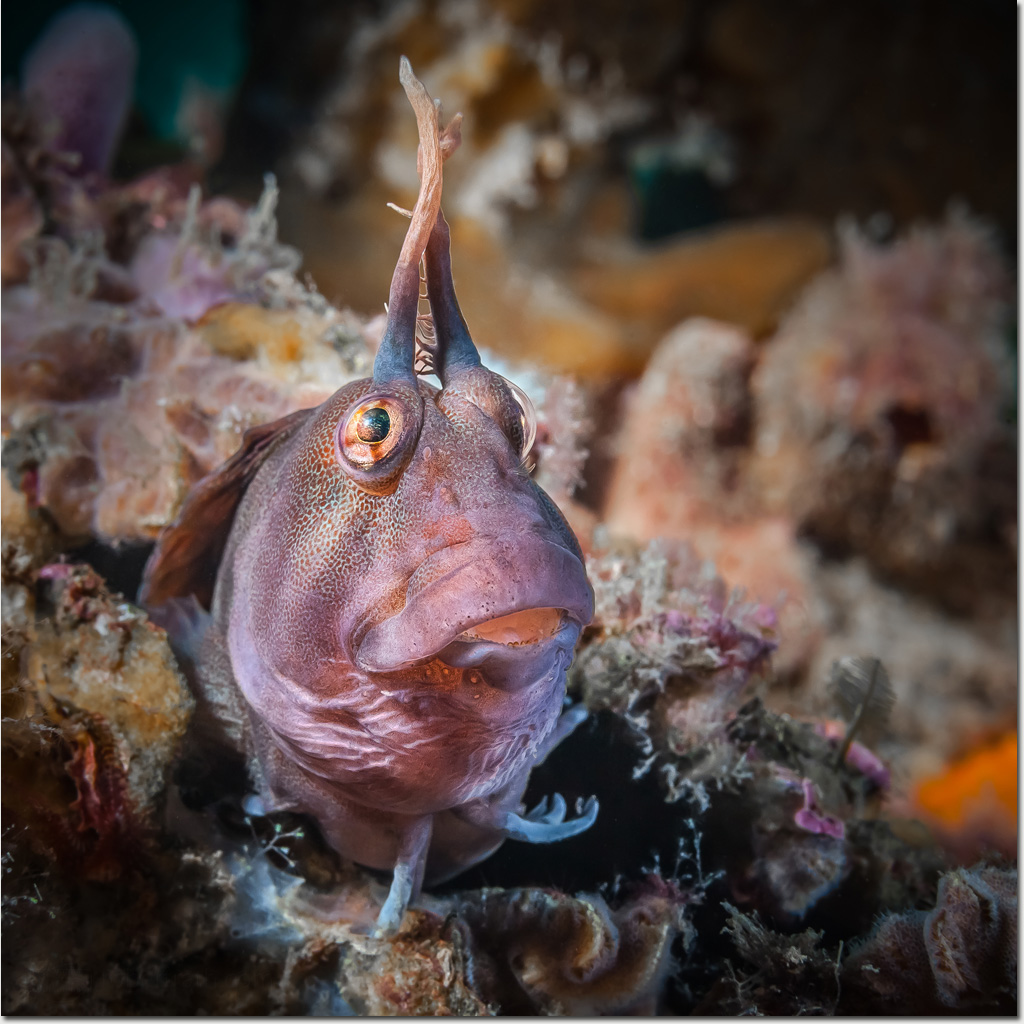
The Tasmanian Blenny, ( Parablennius tasmanianus), is one of those wonderful little critters which can make you smile or even laugh underwater.
Cute, cheeky and full of attitude they will play peek-a-boo with a diver and camera for as long as your patience or tolerance to cold water will last.
This little guy had a cosy little niche in a jetty pylon under Edithburgh Jetty surrounded by a garden of corals, sponges, scallops and algae. The best part for him is that the garden looks after itself!
Next time you spot a blenny on a dive take the time to have a little fun with it. I am sure you will end up with a grin behind your mask.
Photo: Robert Rath, 'Benny', 1/100s f/14 ISO400 50mm
Monday, February 8. 2016
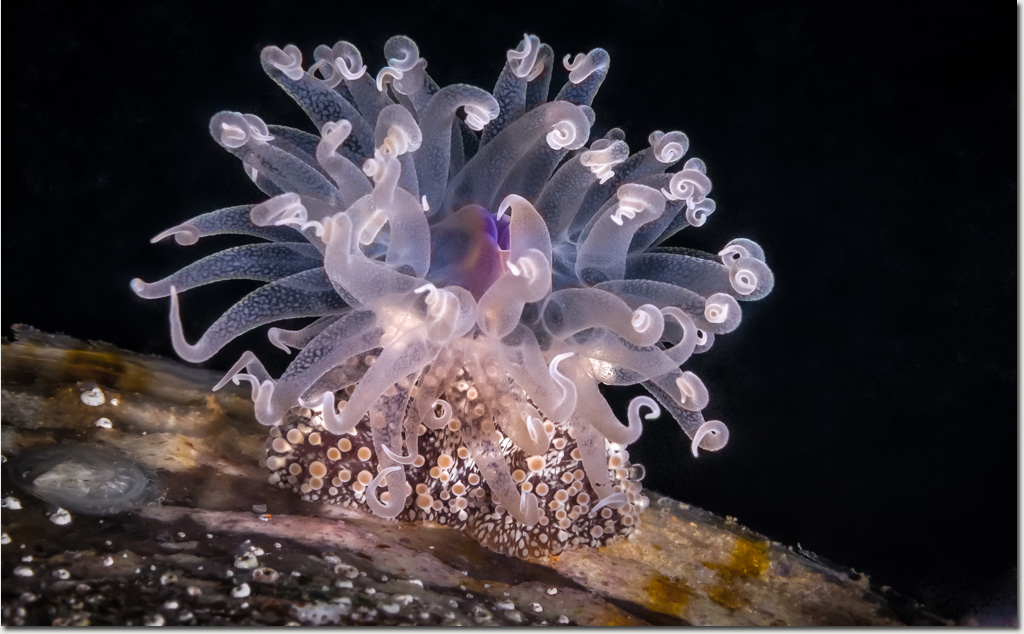
Can you just imagine for a moment at the end of each tentacle a pair of eyes, a mouth and fangs!? Good thing it's not Medusa or I might have become too heavy to swim back to the surface again.
Anemones are usually associated tropical waters, large masses of waving tentacles and cute little anemone fish darting in and out of view. Anemones are however as widespread as there is ocean.
This wonderful little creature perched atop a razor fish is just one of the many species we have here in local South Australian coastal waters.
The minimal number of translucent tentacles, that granular column wall and the velvety oral disk make this anemone just as gorgeous as its tropical cousins and a real little monster.
Photo: Robert Rath, 'Medusa', 1/160s f/22 ISO400 100mm
Sunday, February 7. 2016
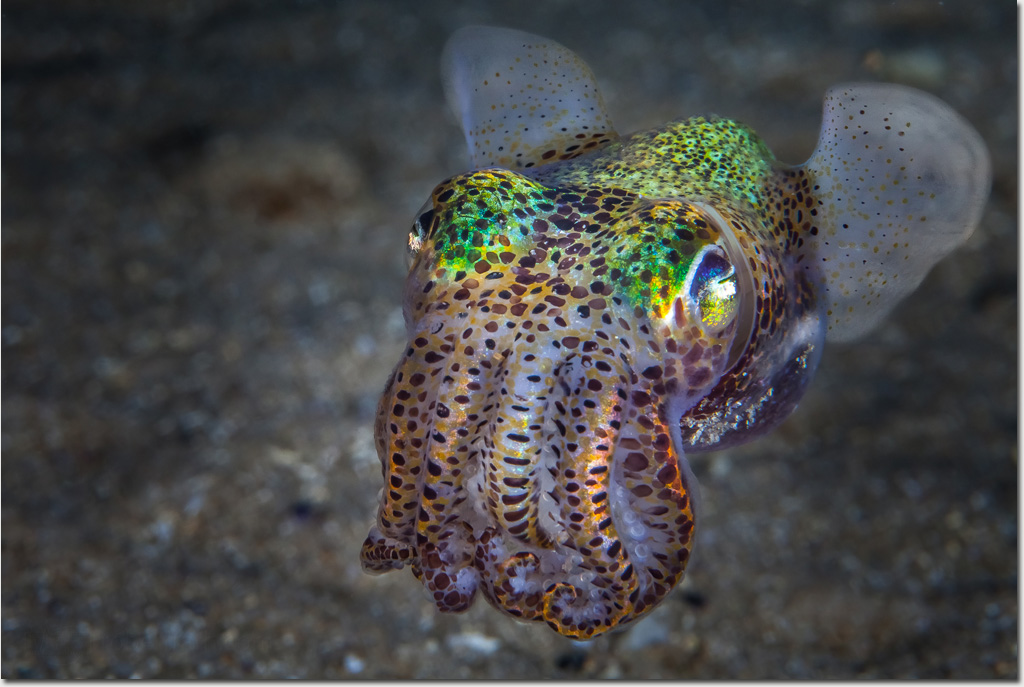
Back home again and what better place to jump back into local water again than a midnight dive at Port Noarlunga.
The visibility was not great, there was some surge and a strong current but nothing stopping another great macro photography session.
There was not much critter action around aside from a huge amount of shellfish mating taking place in the southern weedbeds. My original plan for the dive was to find and photograph nudibranchs but my tally for the night was a big zero.
One highlight of my dive was this awesomely colourful Southern Dumpling Squid, Euprymna tasmanicas. The amazing colours in the dumpling squid are due to the chromataphores in the skin. Using the chromataphores the dumpling squid is able to change its colours to either camouflage or make itself aggressive as needs arise. On a dark night the squid's chromataphores resume this natural colourful state captured in the camera's strobe.
After a very pleasant 2 hours underwater we surfaced to an abandoned jetty, no jetty lights and a starry night sky.
Photo: Robert Rath, 'Creature of Colours', 1/160s f/22 ISO400 100mm
Saturday, February 6. 2016

Most sea slugs do not have common names and the fact that we call them nudibranchs is a nice way to divorce ourselves from the idea of their not so pretty, slimy green garden cousins.
If this little critter had a common name it might be the Splendid Nudibranch but in the literature it is just known as Goniobranchus splendidus.
This species of nudibranch was the very first I saw dropping beneath the water on our Fly Point night dive at Nelson Bay. We saw many of them in the first 2-4m of water so it seems in this location they like the shallows more than deeper water.
It's always exciting meeting a new critter on a dive but at the same time there is a sense of detachment not knowing anything about it, not even its name. For me creating an image and then later taking the time to learn a little more about its name, its habitat and its behaviors is just as rewarding as the dive itself.
Thank you Splendid One for posing for me and teaching me a little more about your world.
Photo: Robert Rath, 'The Splendid One', 1/100s f/22 ISO400 100mm
Thursday, February 4. 2016
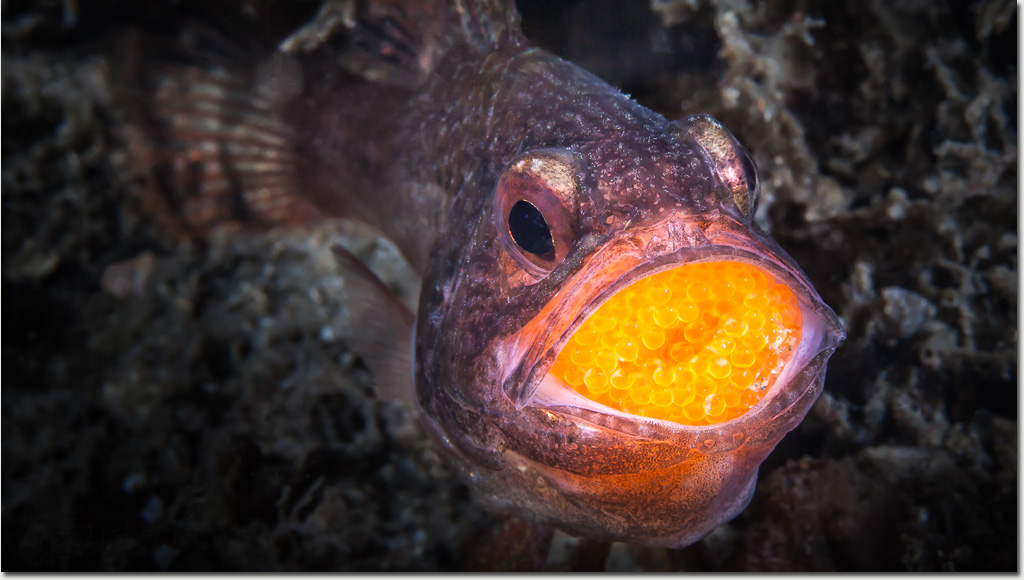
This male Eastern Gobbleguts ( Vincentia novaehollandiae) might look like the perfect husband. He will take full responsibility for his future newborns from the moment the female lays her large egg mass.
He will protect them from predators, he will regularly roll them about to keep them fresh and aerated and he will have you believe that for the entire incubation period he will abstain from eating.
The truth is that every now and then the gobbleguts does swallow and he may not be so hungry after all when it comes time for the babies to hatch.
Photo: Robert Rath, 'Don't Swallow', 1/100s f/22 ISO400 100mm
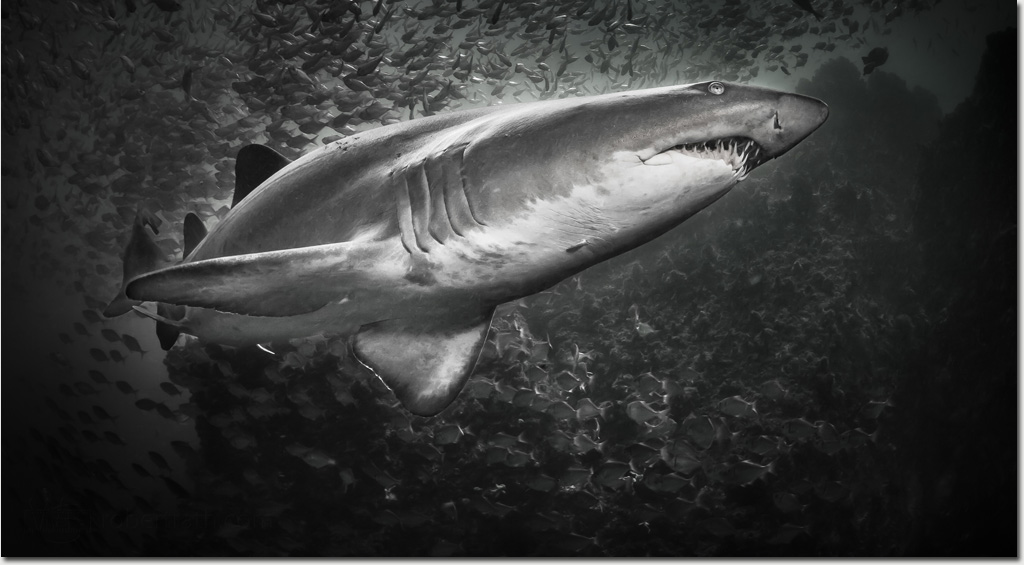
For many people this may very well be outer space being so removed the comfort of the breathable world.
It's not even the lovely crystal clear underwater landscape of a Cousteau Documentary with only a few meters of visibility.
The place is however a very real and very terrestrial Broughton Island and the pace is anything but deadly as this big and beautiful female Grey Nurse shark cruises every so gently by.
Photo: Robert Rath, 'It Came from Outer Space', 1/160s f/14 ISO400 15mm
Tuesday, February 2. 2016

This was my very first visit to the Sea Life Sydney Aquarium and as a diver I was not so sure I was going to enjoy it as much as actually being in the deep wild ocean.
Sure there were many amazing creatures I'd only ever seen photographs of but then I have had many other amazing marine animal experiences this place could never equal.
Then I noticed the people.
I noticed their mouths agape.
I noticed stares of wonder.
I noticed for a moment they were glimpsing a world so removed from the 'day-to-day' that only the moment mattered.
I still have mixed feelings about public aquariums but today I could see that these moments matter and that the things we can do to connect with the oceans and their wonder are indeed worth doing.
Photo: Robert Rath, 'Oh the Wonder', 1/100s f/11 ISO800 17mm
Monday, February 1. 2016
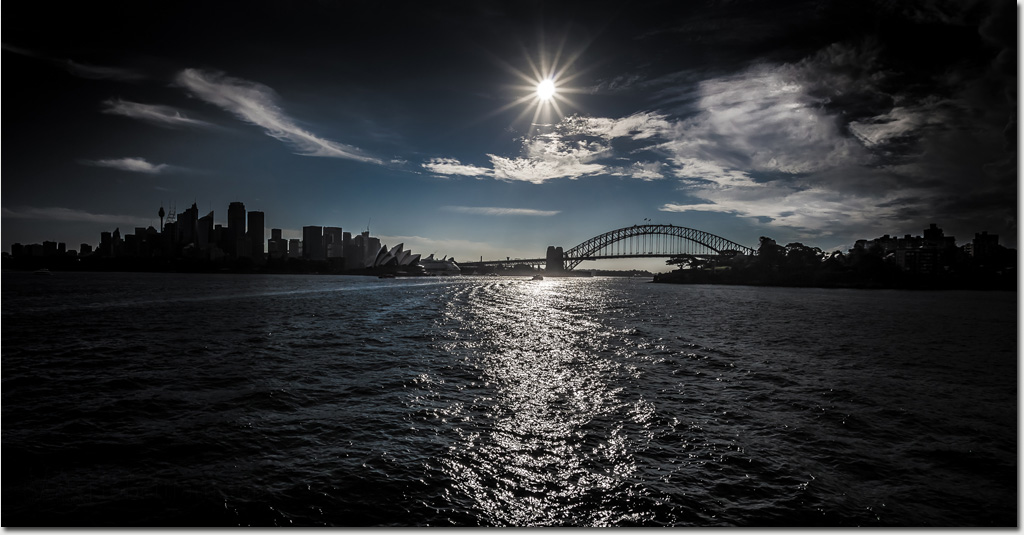
Sydney is one of those cities I just love being in, wandering the streets, sailing the waterways and taking in the bold and brassy spectacle of high-rise and harbour sights.
Although there are plenty of high priced harbour cruises on offer, for just a few dollars you can jump on one of the harbour ferries and spend as much time out on the water as you like.
The Manly Ferry is my favorite with over an hour on the water (return trip) with fantastic views of the Sydney Opera House, the Sydney Harbour Bridge, yachts at play, views out through the heads and of course all those million dollar properties vying for waterfront views along the way.
It's kind of amusing watching the local commuters treat the Sydney Harbour Ferries just like a bus service as they sit inside, reading their papers (yes some still do) or engrossed in their devices missing all that wonder passing by.
Photo: Robert Rath, 'Sydney Harbour', 1/5000s f/13 ISO160 15mm
Sunday, January 31. 2016
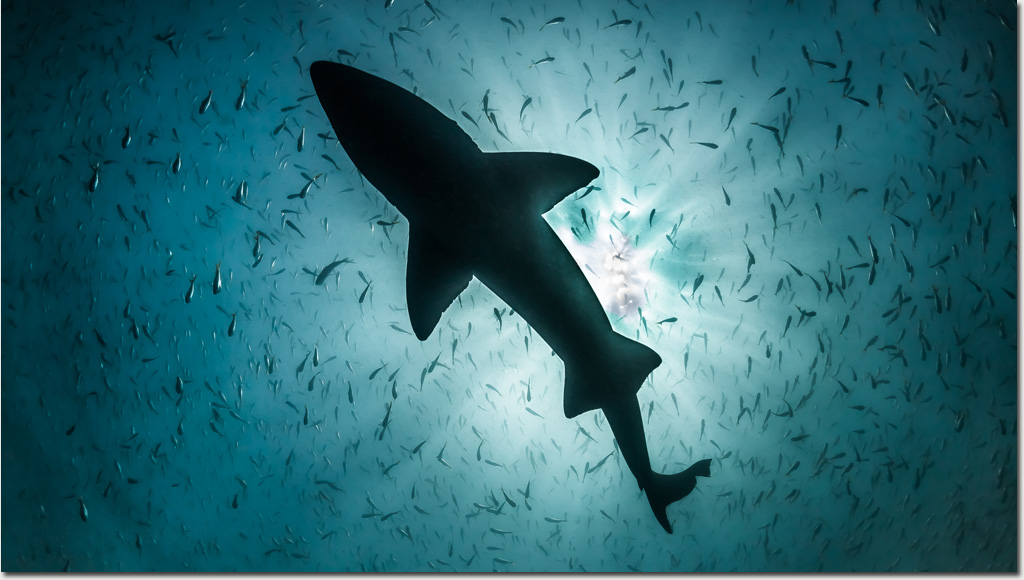
As she cruised over my head the sun was eclipsed and the surrounding water came alive with thousands of mini silhouettes.
For a time she overshadowed them all with grace, girth and length before the sun reappeared and she was gone.
Yet another beautiful moment with a Broughton Island Grey Nurse shark.
Photo: Robert Rath, 'Overshadowed', 1/160s f/22 ISO160 15mm
Saturday, January 30. 2016

I had never dived Nelson Bay before last weekend and as we geared up in the dark at Fly Point for the high tide dive I was acutely aware that I really should dive here in the daylight first.
The moment we submerged though I caught sight of my first nudibranch for the dive, then another and another. In a short span of time I had seen more nudibranchs and a greater variety of nudibranch species than in all of my many years of diving.
I encountered this denizen of the (not so) deep, Dendrodoris denisoni, about 60 minutes into one of the most amazing night dives I have experienced. I could not have asked for a better pose as the nudibranch perched itself atop a piece of structure with its antler-like rhinophores fully extended and rear branchial plume waving in the current.
The remainder of the dive at Fly Point was filled with more nudibranchs, wobbygong sharks, octopuses, gobbleguts and a myriad of fishes.
After this very first dive at Nelson Bay I knew I was in nudibranch heaven!
Photo: Robert Rath, 'Denizen of the Deep', 1/100s f/22 ISO400 100mm
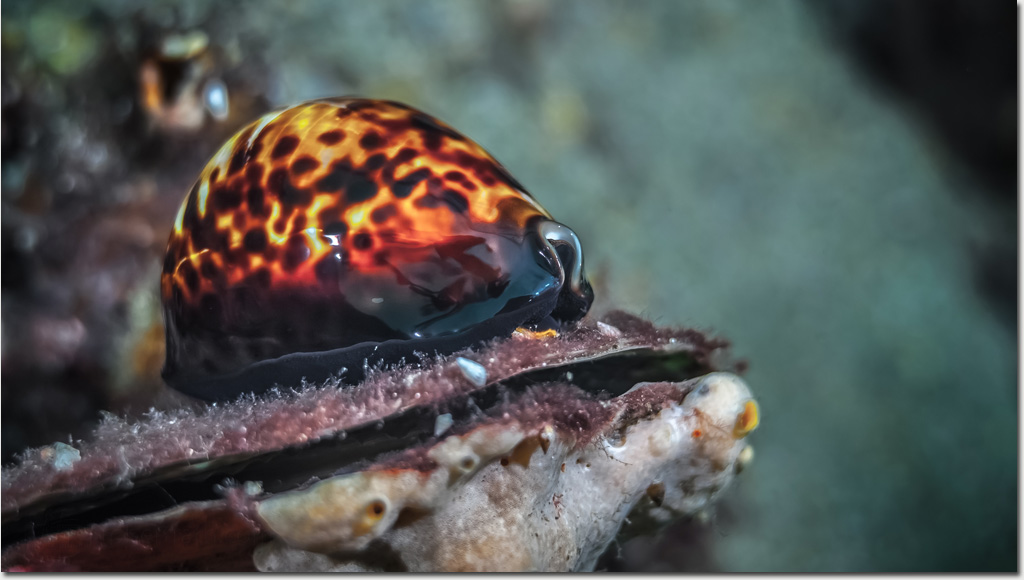
Marine images of shellfish are not high on the list of glamorous marine subjects.
True, most shellfish find it hard to capture attention the way sharks, whales, brightly coloured reef fish and any number of other fascinating marine creatures do though there are exceptions.
The first time I came upon a Black Cowry (Zoila friendii) I was captivated by the lustrous dark glossy shell, the gorgeous yellow, orange and red markings and the black velvet mantle.
In South Australia the Black Cowry is not a protected animal and divers may take one per day from the water in unprotected zones.
In my early diving years I dived with a dedicated group of naturalist divers who were infuriated with the taking of these animals and made it their mission to mark the shell by scratching it with a large cross.
Their argument was that defacing the cowry would make it worthless to collectors.
At the time I could see their argument and every time I found a Black Cowry marked with a cross I new it was safe. I always thought though how sad that divers would never see that beautiful black shell in all its glory.
Now that I am passionate about sharing images of our undersea world I am frustrated when I find a marked cowry.
Obviously the practice still continues but they are reasonably common and it is easy to find one or two on an Edithburgh Jetty dive in all their lustrous glory.
Photo: Robert Rath, 'Black Beauty', 1/80s f/3.2 ISO320 50mm
Thursday, January 28. 2016
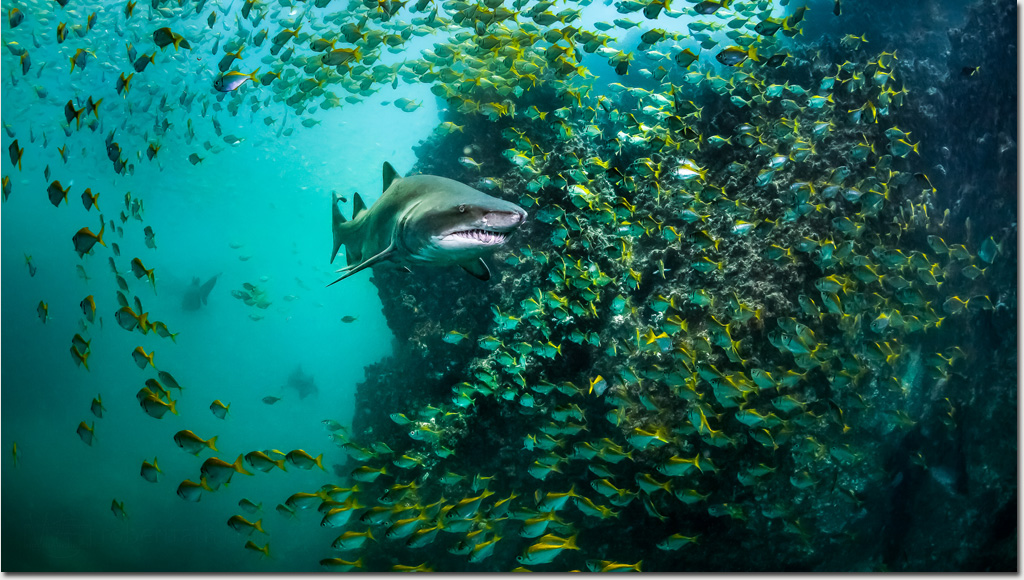
This big female Grey Nurse shark ( Carcharias taurus) might look fierce and if you were the subject of tonight's dinner you might want to think about finding somewhere else to hang out.
The large school of Eastern Pomfred ( Schuetta scalaripinnis) which gently parted to make way for her should have gone a little further as most of them would be on the late evening's menu.
This is my second opportunity to dive with Grey Nurse sharks and my first trip to the Broughton Island Group near Nelson Bay on the New South Wales west coast.
Unfortunately the recent heavy rains meant the visibility was not very good as evidenced by the gloomy background but there were no shortage of these beautiful animals as they cruised by in an almost trance like state. Every now and then one would come from behind and 'accidentally' brush my legs or fins resulting a sudden 'crack' and powerful surge as the shark realised its mistake and made a sudden almost violent course correction in the other direction.
Few things in my diving experience compares with being in the water with large sharks and I plan on doing more of it!
Photo: Robert Rath, 'Grey Nurse', 1/160s f/9 ISO400 15mm
Monday, January 25. 2016
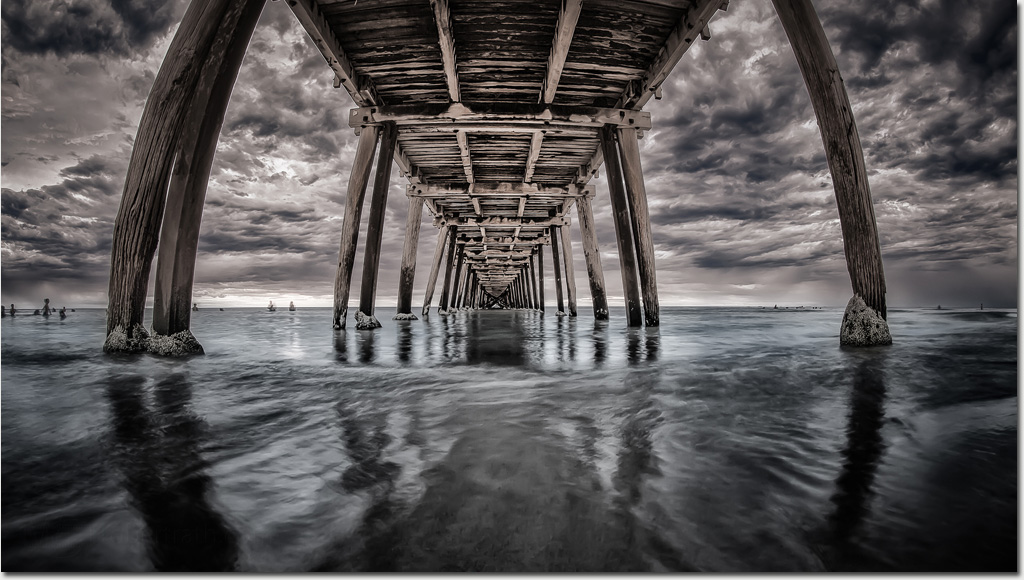
I am not a big fan of over processed images and generally favour subtle tones and detail.
On this occasion thought the clouds were so intense and brooding that a dramatic representation was all I could think of.
At the same time I have just started experimenting with Silver Efex Pro in the Google Nik Collection.
Until I settle down with these new tools learn how to use them well, expect a little drama!
Photo: Robert Rath, 'Quicksilver Reflections', 1.3s f/20 ISO320 15mm
Saturday, January 23. 2016
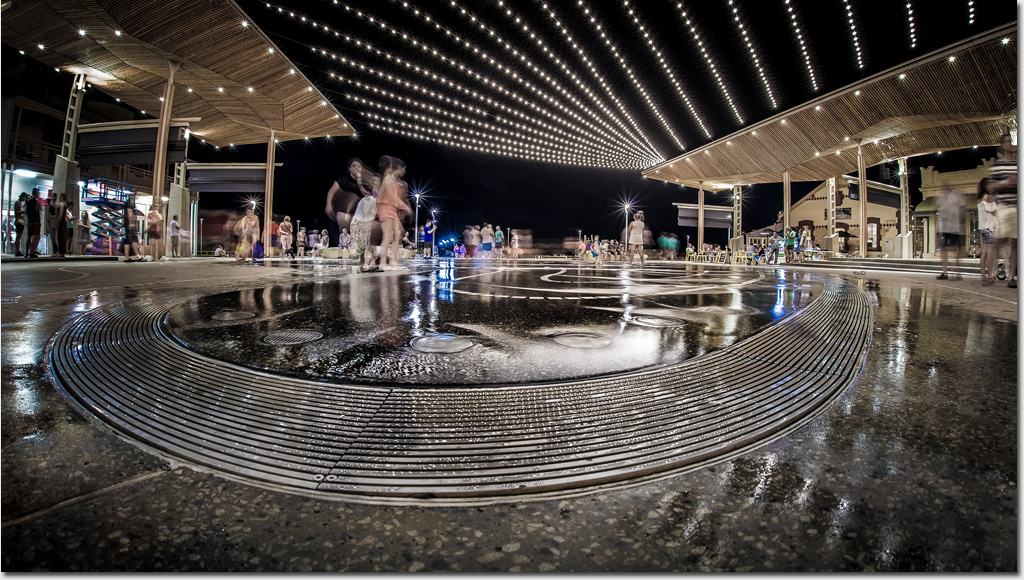
It's all splashes and sparkles and plenty of civic bling at Henley Square now that the construction work is complete.
On a hot summer evening children play in the open-air water feature while an aerial light-show plays above.
People mingle after dinner in one of the restaurants discussing their meal, their day or choosing which bar to head on to.
As pretty as it all is now this wonderful civic facility has had its casualties. During construction businesses suffered, some did not recover.
I loved coming down here before and I love coming down here now. I'm really not sure if the pain was all worth it but I hope at least they keep Henley Square's new bling polished, splashy and sparkling.
Photo: Robert Rath, 'Splashes and Sparkles', 2s f/9 ISO1000 15mm
Friday, January 22. 2016
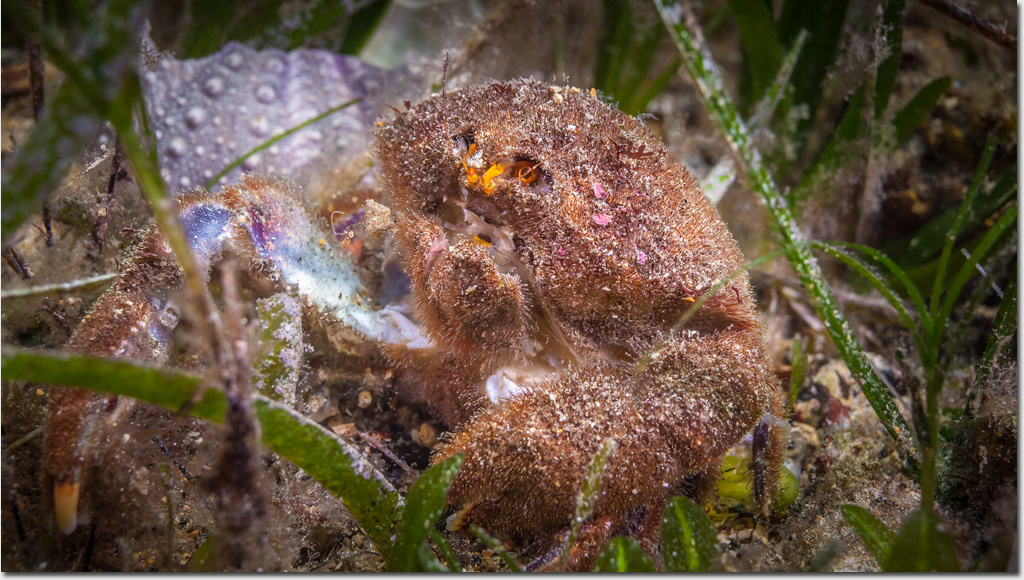
Most South Australian's experience with crabs involves eating them or catching them and usually if they are local they are our blue swimmer species.
As divers we do see blue swimmer crabs in Saint Vincent's Gulf but most crabs we see around jetties and reefs are way more interesting.
We have spider crabs and sand crabs and decorator crabs and hermit crabs and rock crabs and helmet crabs and sponge crabs just to name a few we see regularly.
This Sponge Crab (Austrodromidia octodentata) is one of many species which grow algae and sponge on its shell as a form of camouflage. Very often the entire top surface of one of these guys will be just one big sponge.
This guy obviously has no sponge and looking more closely at the fine brown covering of its shell I wonder if the hair-like structures are an open invitation for a new sponge resident, ie crab carapace for rent.
For now it seems happy about the vacancy as it goes about its benthic business.
Photo: Robert Rath, 'SpongeBob', 1/200s f/7.1 ISO100 50mm
Thursday, January 21. 2016

Magic Mirror on the ocean floor, who is the cutest one of all?
Whether admiring its cuteness, looking for a mate or just checking that nothing is out of place before a big date, this Magic Mirror seems most welcome.
It's usually not nice to see junk thrown into the ocean. Plastic bags, damaged fishing gear and discarded packaging are a real threat to marine life as well as being a blight on and below the water.
Some junk however is quite welcome. Building rubble turned into reefy structures, scuttled ships into mini ecosystems, glass bottles into octopus homes with a view. Even mirrors seem to be put to good use!!
So who is the cutest one of all? Under the sea this Southern Pygmy Leatherjacket ( Brachaluteres jacksonianus) is a fair contender.
Photo: Robert Rath, 'Magic Mirror', 1/200s f/13 ISO320 50mm
Wednesday, January 20. 2016
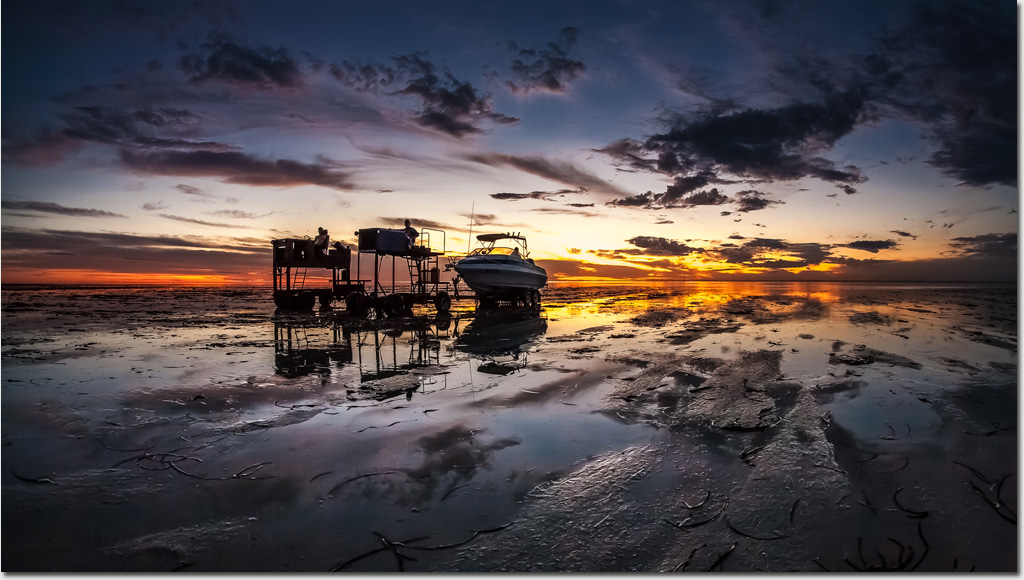
From a cold Austrian winter to balmy Australian evenings the difference between these two worlds could not be more different despite only an 'al' in name.
The place is Port Parham, a ramshackle collection of holiday shacks on the Gulf of Saint Vincent in South Australia and the holiday destination of my childhood.
When the tide goes out here it goes a long, long, long way out. When the tide comes in you can have fun jogging back to the shoreline with the incoming tide lapping at your heals.
As a child I thought these beach tractors were the coolest vehicles on the planet. If you were lucky enough to get a ride on one you could see for miles and miles and even better was that they would drive out into the water when they finally got to it.
The owner of this boat had waited patiently for some time before his ride came to tow him home. Not that anyone would mind waiting on a balmy summer evening with a sky like that.
This evening was a nostalgic moment for me seeing Port Parham the way I always remembered it.
Photo: Robert Rath, 'The Long Tow Home', 1/5s f/11 ISO320 15mm
Monday, January 18. 2016
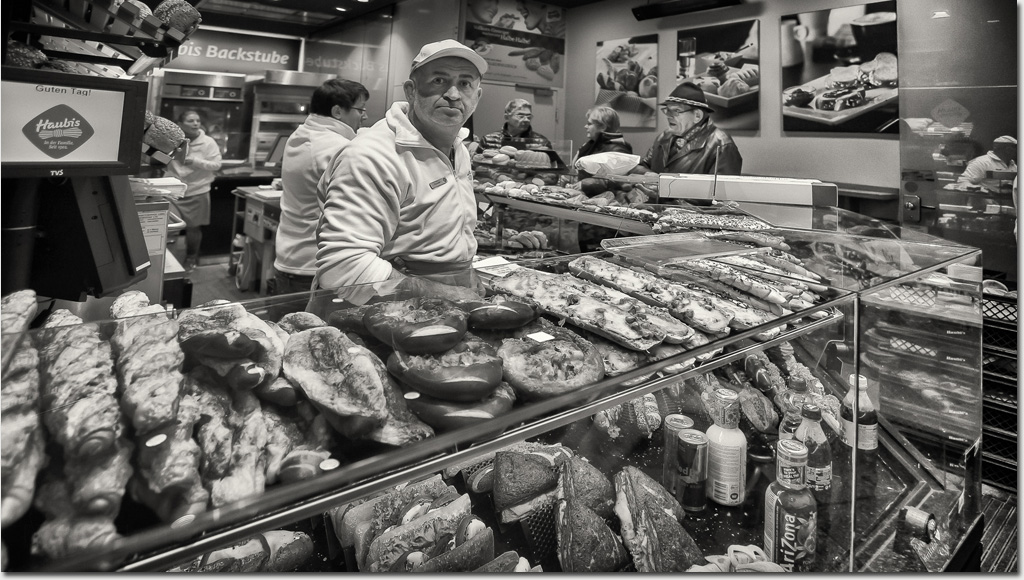
I have been actively avoiding black and white street photography because I feel the genre is somewhat overdone and images I see are often clichéd.
Street images are often full of colour and the idea of giving up all that beautiful colour for the sake of a style or an expectation of style seems a little contrarian.
Regardless, every now and then I like to try something in black and white. Not because 'it works better in B&W', an expression which makes me cringe whenever I hear it, but because I love the tones and textures and that caught my attention.
Perhaps the two ideas amount to the same thing in choosing to go B&W but for me I need to know why I have made this choice as much as liking the feel of it.
The Haubis Backstube on Landstraße in Linz caught my eye, or perhaps it was my nose, as we strolled passed. The man behind the counter caught my gaze and a moment later we were gone.
It's nice to re-live this ever so brief moment and those black and white textures and tone help me to remember why I captured it.
Photo: Robert Rath, 'Guten Tag', 1/250s f/4 ISO800 17mm
Saturday, January 16. 2016
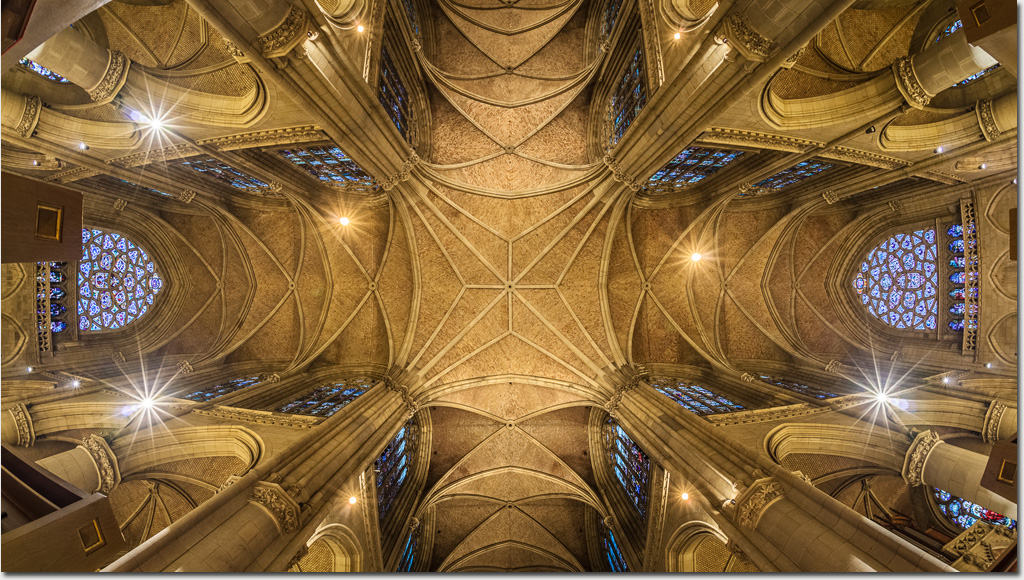
Looking up towards heaven inside The Cathedral of the Immaculate Conception in Linz, Austria.
When The New Cathedral was designed it was to be the largest, tallest and most majestic cathedral in Austria. The bureaucracy had decreed however that in Austria-Hungary no building was allowed to be higher than Saint Stephen's Cathedral in Vienna.
Stifled by politics and bureaucracy the spire rising above this new heaven was cut short 2 metres on the side of political correctness.
Photo: Robert Rath, 'Der Neue Himmel', 2s f/7.1 ISO800 15mm
Friday, January 15. 2016

My very first memories of this place come from photographs taken by my father when I was too young to remember.
Swans on the Danube, misty fog in the autumn and snow in winter. Memories of photographs of feeding swans, of sledding through the streets of Aschach and bright eyes full of wonder.
For 25 years my life was filled with hot summers, blue skies, arid landscapes and snow capped mountains were just some myth of nature. Austria could not have been further from my mind.
That began to change when I came back here with my father. It was a wonder to me and an emotional homecoming for him. For most of that visit we left my father to reacquaint himself with family and friends while we played tourists. When it was time to return to Australia the goodbyes were very intense full of tears and emotion as my father knew then it would be last time he would see Aschach, the Danube and his childhood friends.
After that first homecoming it was another 13 years before I would be back here in Aschach and it was then that I experienced a profound shift in my feelings for this place. My family and I felt a welcoming connection which was quite different from the first time. We spent all of our time here with family and friends and the beauty of the Austrian countryside became incidental.
It was then I made a promise to myself, to my Austrian and my Australian families that I would never let the connection slip again and we would come back as often as we can. And we do.
Photo: Robert Rath, 'Homecoming', 1/200s f/13 ISO640 17mm
Thursday, January 14. 2016

These red bulls in the little village of Fuschl are only statues but if they were real and headed your way they really might give you wings to get away!
These Red Bulls are the only clue to their corporate owners tucked away here in the beautiful Salzburg region of Austria.
Actually Red Bull was successfully sued in 2014 for false advertising by a man who after drinking Red Bull for 10 years complained that he still had no wings.
Maybe they should have let the bulls loose on him. Perhaps he would have discovered he could fly after all.
Photo: Robert Rath, 'Red Bulls', 1/320s f/8 ISO160 105mm
|
